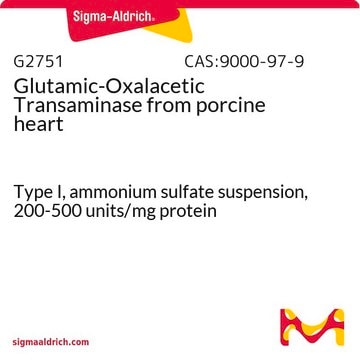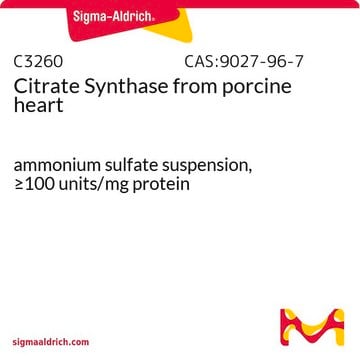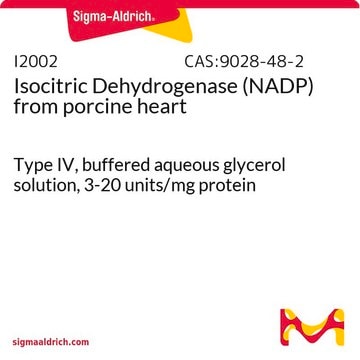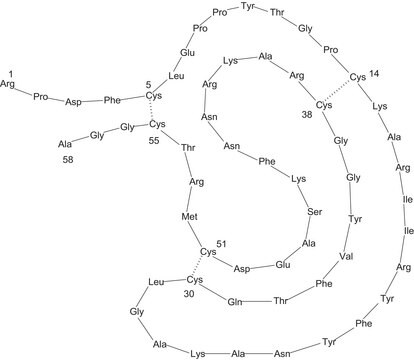A5384
Aconitase from porcine heart
Synonym(s):
Aconitate hydratase, Citrate (isocitrate) hydrolyase
Sign Into View Organizational & Contract Pricing
All Photos(1)
About This Item
CAS Number:
MDL number:
UNSPSC Code:
12352204
NACRES:
NA.54
Recommended Products
biological source
Porcine heart
form
solid
mol wt
~66 kDa by gel filtration
storage temp.
−20°C
Application
Aconitase may be usefull in diabetes research as well as to study structural conservation between iron-responsive element binding proteins (IRE-BP) and isomerases .
Biochem/physiol Actions
Aconitase catalyses the stereo-specific isomerization of citrate to isocitrate via cis-aconitate in the tricarboxylic acid cycle. Aconitase is inhibited by cyanide, sulfide and copper and mercury at low concentrations. It is competitively inhibited by trans-aconitate. Aconitase contains an internal Fe-S cluster which is responsible for its activity.
Unit Definition
One unit will convert 1.0 μmole of citrate (via cis-aconitate) to isocitrate per min at pH 7.4 at 25 °C.
Analysis Note
Crude preparation containing aconitase activity
Storage Class Code
11 - Combustible Solids
WGK
WGK 3
Flash Point(F)
Not applicable
Flash Point(C)
Not applicable
Personal Protective Equipment
dust mask type N95 (US), Eyeshields, Gloves
Choose from one of the most recent versions:
Certificates of Analysis (COA)
Lot/Batch Number
Don't see the Right Version?
If you require a particular version, you can look up a specific certificate by the Lot or Batch number.
Already Own This Product?
Find documentation for the products that you have recently purchased in the Document Library.
Customers Also Viewed
Geoffrey F Kelso et al.
Chemistry & biology, 19(10), 1237-1246 (2012-10-30)
Superoxide (O(2)(·-)) is the proximal mitochondrial reactive oxygen species underlying pathology and redox signaling. This central role prioritizes development of a mitochondria-targeted reagent selective for controlling O(2)(·-). We have conjugated a mitochondria-targeting triphenylphosphonium (TPP) cation to a O(2)(·-)-selective pentaaza macrocyclic
Meghna Mittal et al.
Microbiology (Reading, England), 159(Pt 1), 68-76 (2012-11-10)
The role of the CcpC regulatory protein as a repressor of the genes encoding the tricarboxylic acid branch enzymes of the Krebs cycle (citrate synthase, citZ; aconitase, citB; and isocitrate dehydrogenase, citC) has been established for both Bacillus subtilis and
S S Popov et al.
Eksperimental'naia i klinicheskaia farmakologiia, 75(7), 32-35 (2012-10-03)
A combined therapy with melaxen led to a decrease in the activity of gamma-glutamyl transpeptidase and the level of diene conjugates in blood serum of patients with the drug-induced hepatitis developing on the background of administration of antituberculous preparations. These
Béatrice Py et al.
Molecular microbiology, 86(1), 155-171 (2012-09-13)
Biosynthesis of iron-sulphur (Fe-S) proteins is catalysed by multi-protein systems, ISC and SUF. However, 'non-ISC, non-SUF' Fe-S biosynthesis factors have been described, both in prokaryotes and eukaryotes. Here we report in vitro and in vivo investigations of such a 'non-ISC
Megan J Morgan et al.
Plant physiology, 161(1), 397-407 (2012-11-21)
Organic acid content is regarded as one of the most important quality traits of fresh tomato (Solanum lycopersicum). However, the complexity of carboxylic acid metabolism and storage means that it is difficult to predict the best way to engineer altered
Our team of scientists has experience in all areas of research including Life Science, Material Science, Chemical Synthesis, Chromatography, Analytical and many others.
Contact Technical Service









